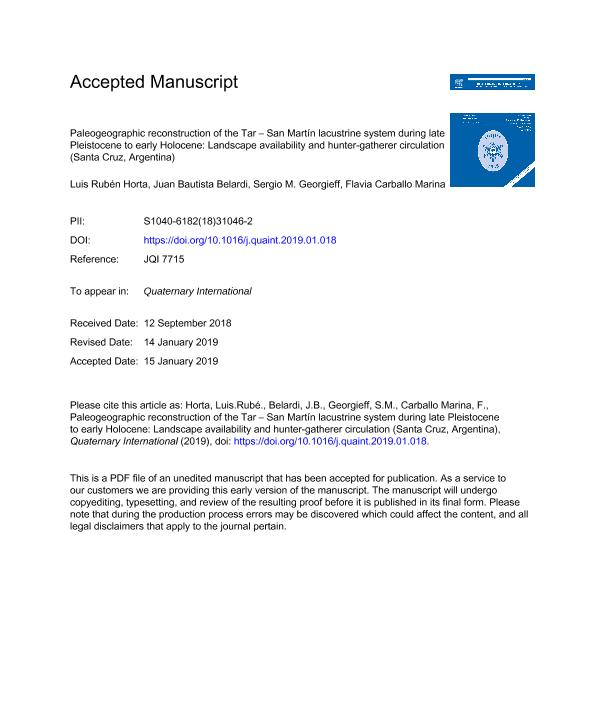Mostrar el registro sencillo del ítem
dc.contributor.author
Horta, Luis Rubén

dc.contributor.author
Belardi, Juan Bautista

dc.contributor.author
Georgieff, Sergio Miguel

dc.contributor.author
Carballo Marina, Flavia Elena

dc.date.available
2020-08-21T15:11:26Z
dc.date.issued
2019-04
dc.identifier.citation
Horta, Luis Rubén; Belardi, Juan Bautista; Georgieff, Sergio Miguel; Carballo Marina, Flavia Elena; Paleogeographic reconstruction of the Tar – San Martín lacustrine system during late Pleistocene to early Holocene: Landscape availability and hunter-gatherer circulation (Santa Cruz, Argentina); Pergamon-Elsevier Science Ltd; Quaternary International; 512; 4-2019; 45-51
dc.identifier.issn
1040-6182
dc.identifier.uri
http://hdl.handle.net/11336/112128
dc.description.abstract
This paper presents the paleogeographic reconstructions of flooded areas of the Tar - San Martín lacustrine system during the late Pleistocene - Holocene. The dimensions of lacustrine and glaciolacustrine levels of this basin are higher than the current levels of the lakes. The organic matter of lake levels recorded on stratigraphic profiles was described, sampled and dated using AMS, while other paleobathymetric indicators were also identified (height of the fan-delta apex and paleo-coast levels). Deriving out of the reconstruction of flooded areas it was established that the lake system was formed before 28 ka ago and would have reached its maximum expansion around 12 ka ago. The first hunter-gatherer occupation of the basin (11 ka)corresponds to the period of initial contraction of the lake system and the composition of the current configuration of the coastlines. This scenario would have allowed the exploration of western areas and the gradual incorporation of the forest to the action range of hunter-gatherer populations. Similarly, the levels of lakes Tar and San Martín would not have hindered the movement of human populations through the steppe throughout the Holocene.
dc.format
application/pdf
dc.language.iso
eng
dc.publisher
Pergamon-Elsevier Science Ltd

dc.rights
info:eu-repo/semantics/openAccess
dc.rights.uri
https://creativecommons.org/licenses/by-nc-nd/2.5/ar/
dc.subject
CLIMATIC CHANGES
dc.subject
LACUSTRINE SYSTEM
dc.subject
PALEOGEOGRAPHIC RECONTRUCTIONS
dc.subject
PATAGONIA
dc.subject.classification
Geociencias multidisciplinaria

dc.subject.classification
Ciencias de la Tierra y relacionadas con el Medio Ambiente

dc.subject.classification
CIENCIAS NATURALES Y EXACTAS

dc.title
Paleogeographic reconstruction of the Tar – San Martín lacustrine system during late Pleistocene to early Holocene: Landscape availability and hunter-gatherer circulation (Santa Cruz, Argentina)
dc.type
info:eu-repo/semantics/article
dc.type
info:ar-repo/semantics/artículo
dc.type
info:eu-repo/semantics/publishedVersion
dc.date.updated
2020-08-19T19:37:34Z
dc.journal.volume
512
dc.journal.pagination
45-51
dc.journal.pais
Estados Unidos

dc.description.fil
Fil: Horta, Luis Rubén. Universidad Nacional de La Rioja; Argentina. Consejo Nacional de Investigaciones Científicas y Técnicas. Centro Científico Tecnológico Conicet - Tucumán. Instituto Superior de Estudios Sociales. Universidad Nacional de Tucumán. Instituto Superior de Estudios Sociales; Argentina
dc.description.fil
Fil: Belardi, Juan Bautista. Universidad Nacional de la Patagonia Austral; Argentina. Consejo Nacional de Investigaciones Científicas y Técnicas; Argentina
dc.description.fil
Fil: Georgieff, Sergio Miguel. Universidad Nacional de Tucumán. Facultad de Ciencias Naturales e Instituto Miguel Lillo; Argentina. Consejo Nacional de Investigaciones Científicas y Técnicas; Argentina
dc.description.fil
Fil: Carballo Marina, Flavia Elena. Universidad Nacional de la Patagonia Austral; Argentina
dc.journal.title
Quaternary International

dc.relation.alternativeid
info:eu-repo/semantics/altIdentifier/url/https://www.sciencedirect.com/science/article/abs/pii/S1040618218310462
dc.relation.alternativeid
info:eu-repo/semantics/altIdentifier/doi/http://dx.doi.org/10.1016/j.quaint.2019.01.018
Archivos asociados
